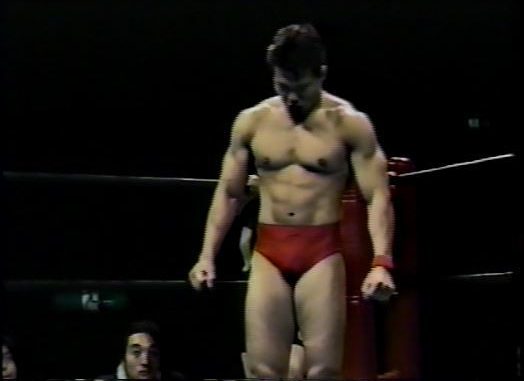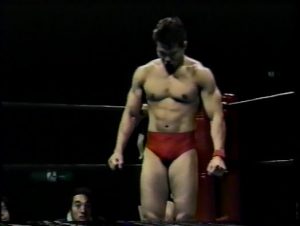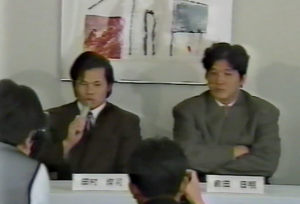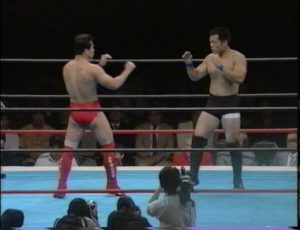
Kiyoshi Tamura and the Case for the Wrestling Observer Hall of Fame
By: Jonathan Snowden

It makes sense that shootstyle wrestling emerged in 1984, a final desperate plea for a return to the old ways when wrestling was still wrestling. That was the same year Hulk Hogan won the WWF championship in Madison Square Garden, the year Roddy Piper smashed a coconut over Jimmy Snuka’s head in his famous Pit, the year the Road Warriors usurped the old guard represented by Baron Von Rasche and the Crusher.
The business was changing—and some thought not for the better.
It was also, perhaps not coincidentally, the same year a group of renegades, unhappy with the Americanization of puroresu (and Antonio Inoki’s political maneuvering and bad business deals), left New Japan Pro Wrestling to seek their own path. Led by Akira Maeda, Yoshiaki Fujiwara, and Tiger Mask, the newly formed UWF spent two years struggling to balance realism with the pure creative zeal fans had begun to associate with professional wrestling.
Lack of money and television eventually sent them crawling back to New Japan. But its artistic impact on the sport of professional wrestling is undeniable. The UWF would eventually become famous for creating “shootstyle” a throwback promotion grounded in realistic catch wrestling holds and other legitimate martial arts techniques. Some of the biggest stars of the 1990s were launched into the collective consciousness of hardcore Japanese wrestling fans on these obscure, niche shows.
And their idea was not ready to die. Not yet. Like a phoenix, shootstyle emerged again in 1988, propelled this time by a Maeda cheapshot to the face of Riki Choshu, metaphorically a kick to the face of the entire wrestling establishment. Maeda took his original UWF compatriots and their proteges with him on his way out the door, in the blink of an eye creating a powerhouse promotion from nothing.
The UWF was back—and this time fans were waiting for it.
Immediately a hot ticket, by 1989 they were on fire, putting an announced 60,000 in the Tokyo Dome without the power of a major television deal. If you wanted to see the UWF, you had to show up to the building and watch it live. The result was a full building every month, fans desperate to watch the self-proclaimed toughest wrestlers in the business.
It’s here that Kiyoshi Tamura enters our story.
Tamura
While he didn’t join the promotion with Minoru Suzuki’s amateur pedigree or Masakatsu Funaki’s stature as a prized New Japan prospect, it was obvious right away that Tamura had something special. By his third match, he was already outworking a veteran like Yoji Anjoh, keeping things interesting with fluid transitions from position to position. This is worth noting because this was not the prevalent style at a time when guys were willing to just sit in a hold before eventually finding the ropes or inexplicably breaking free.
Tamura, already known as one of the toughest guys in the dojo, and a man who would eventually become an excellent shooter and MMA star, had a different vision for what wrestling should look like. You could see it, both in his early, even-steven undercard bouts, and even in the biggest bout of his young career, a one-sided loss to superstar Akira Maeda. In truth, this was a squash match. But Tamura’s commitment to the role made it one so visceral that fans who have seen it recall it almost 30 years later.
The match is best remembered for a series of full-force knees to Tamura’s head, blows that would keep the young up-and-comer out of action for a year with broken facial bones. But one of the moments that stands out to me is a much smaller glimpse at the wrestler Tamura would become. After a rope break, he stays on the mat, taking another count and losing a point, selling the cumulative damage he’d taken. It’s very subtle, but that kind of work, outside the old grandmaster Yoshiaki Fujiwara, simply didn’t exist in the UWF style until Tamura brought it to the forefront.
In some ways, shootstyle wrestling is the hardest to pull off. The bouts, even between the biggest stars, are like extended Young Lions matches, limited only to moves and strategies that fit loosely within the realm of the possible. The wrestlers are like artists robbed of most of the colors on the spectrum, limited to mere primary colors as they attempt to paint a masterpiece. We know a lot about what good shootstyle wrestling looks like (and even more about what it looks like when it’s bad) because for nearly a decade Tokyo was home to an experiment that captured fan interest for an entire generation.
For most, the result is either meandering and boring, a collection of the same moves done over and over again until the audience’s eyes glaze over, or stilted and robotic, with wrestlers so worried about coloring between the lines that they lose the fluidity necessary to deliver a dynamic performance. If a bout looks too much like a real fight, it’s likely to lack the drama and excitement pro wrestling fans desire. But if a wrestler goes too far in the other direction towards traditional pro wrestling, it no longer even resembles an athletic contest. The illusion of reality, which is the whole point really, is completely gone.
From his first moments in the promotion, Tamura was already changing the style for the better, always with an eye towards making the grappling look more and more realistic. The trick was doing it without sacrificing highspots and the sense of drama that separates the best pro wrestling from any other form of entertainment in the world.
The Maeda match left Tamura with a shattered face and, by the time he had finished his medical treatment, the promotion was heading towards an explosive end. What had been a single strong team split into three, each with its own unique spin on what shootstyle wrestling should. Interestingly, the king of realism went with the group whose style most resembled traditional pro wrestling, Nobuhiko Takada’s UWF-International.
Despite not matching his personal inclinations entirely, this ended up being a brilliant move for Tamura. He escaped the PWF-G bound Suzuki and Funaki, fellow rising stars who were a little ahead of him in the UWF pecking order and was the biggest fish in a much smaller pond of developing talent with UWF-I.
Tamura was widely acknowledged by his peers as being both the best pro prospect and the most capable young guy in the dojo, no small feat considering this group included gargantuan future pro wrestling superstar Yoshihiro Takayama and eventual Pride sensation Kazushi Sakuraba.
“Tamura, that was another tough bastard,” former UWFI wrestler Mark Fleming remembers. “Lou (Thesz, Fleming’s mentor) thought he was the best of the whole bunch. He was the toughest shooter. He wrestled and he was not a very big guy. He weighed about 220 at the most. But, he was in shape and he wrestled, he wrestled on the mat. And Lou said he was the best wrestler we had of them all.”
Inside the ring, Tamura continued to excel. You can see glimpses of greatness to come even in 1991. His first match with Gary Albright, one of the best rivalries of his career, is a good example of the small touches he brought to each match. Albright tossed people around in every bout—but watch how Tamura fights the underhooks before eventually going airborne. He made every exchange look like a competition, benefiting both himself and his opponent, who always looked stronger by having to overcome some resistance.
He had his first main event in 1993 against Takada, then filled the main or co-main slot three times at the enormous Budokan Hall in 1994. He was equally adept at working with contemporary athletic types and the enormous gaijin monsters the promotion was built around at the time, managing to make both Vader and Gary Albright look strong before important title bouts without sacrificing his own heat and standing with the fans. That’s a narrow line, but Tamura walked it as well as anyone, always looking potent, even in the midst of crushing defeat.
At this point, he was clearly the best technician, not just in a promotion full of them, but likely in the entire world. He was the rare wrestler with every tool—his offense looked great, both on the mat and standing, he sold every big move like he could see Death on the horizon, and, most importantly, mastered the little things. Tamura wasn’t a “your turn, my turn” guy in the contemporary style. There’s was a build up, not just within the match itself, but to execute a single move. His was. subtle genius, blocking and avoiding holds and blows, reversing them, then having a trick up his red Speedos to counter whatever his opponent came up with in turn.
By 1995, Tamura could hardly be denied anymore. Unfortunately, his ascension came just as the UWFi began its long spiral from the stratosphere to the history books. The reasons are numerous—a disastrous excursion to Los Angeles by Yoji Anjoh to challenge Rickson Gracie. Takada’s tepid response and the emergence of Pancrase and UFC to demonstrate pretty clearly that UWFi was nothing more than pro wrestling. Brutal and elegant, but just as fake as the other promotions they had spent years railing against.
RINGS
In August, Tamura headlined what would be the last proper UWFi show in front of a fairly robust crowd at Tokyo Bay NK Hall. Two months later, Takada was doing the job for the Great Muta in New Japan Pro Wrestling and the UWFi became the first of the UWF offshoots to well and truly fail—at least until they regrouped and helped found Pride Fighting Championships (a story for another time).
The crowd is absolutely ecstatic about his debut, giving him a hero’s welcome of the kind normally reserved exclusively for Maeda himself. His first match with RINGS mainstay Dick Leon Vrij is brilliant, the kind of bout you have to watch very closely to tell if they are working or shooting. Whatever they are doing (spoiler alert, working) they are doing it masterfully. Tamura, of course, was just getting started. In September, he and the masterful Dagestani Volk Han would have what was up until then the greatest bout in shootstyle history, only to top it (at least arguably) a year later.
Though the two only met four times in singles matches, it was one of those perfect wrestling partnerships that turn a special art form into something truly sublime. They were a shootstyle Misawa and Kawada, HBK and Bret Hart if they could have gotten themselves together, wrestlers born to be in the ring together. Everything they did had a hint of realism, but real life in technicolor, a little sharper and more vivid than anything you might have ever thought possible. Compared to anything else in wrestling history, even to his great UWFi matches, this was simulated grappling with the fast-forward button stuck on 2X—almost impossibly fast, yet somehow never missing a beat.
If Han alone had been Tamura’s only great opponent, we wouldn’t be having this conversation. Instead, good matches were the norm with competent opponents like Hans Nyman or Yoshihisa Yamamoto and unquestioned excellence could be pulled from physically talented grapplers like Mikhail Ilyukhin, perhaps best known for a questionable submission win over Randy Couture (or for poking his chin in Igor Vovchancyn’s eye in the old days of NHB).
But Tamura saved his best for Tsuyoshi Kosaka, the former judo stalwart and UFC title contender who became one of the greatest wrestling craftsmen of all time. Like with Han, the two met only four times in the ring, each a gift from the wrestling gods in its own way. The best, in most people’s eyes, was a time limit draw on 6/27/98 in Tokyo.
Most wrestlers settle into a pattern. Even the best ones, basically, do variations of the same thing in every bout. Not so Kiyoshi Tamura. In 1997 he had two other-worldly matches with Han, both stylistic flights of fancy, extended grappling highspots that exist in a world loftier, fancier and more glorious than our own. A year later, he had the greatest match of his or anyone’s life, working a style that couldn’t be more different, a staggeringly realistic contest with Kosaka. You don’t usually think of shootstyle wrestlers being particularly diverse or adaptable, but perhaps that’s why Tamura belongs at the head of the table?
A month later, Tamura’s world changed. Akira Maeda had the first of two retirement matches at Yokohama Arena and his understudy was left to assume the main role at last. Unfortunately, the landscape was desolate, with RINGS the last major player still standing among the UWF spinoffs of 1991.
The Death of Shootstyle
UWFi was gone for good and PWF-G had become Pancrase and was struggling to run buildings bigger than Korakuen Hall. Pride FC and K-1 had captured the audience’s heart and merely pretending to fight for real didn’t tap into the same energies it once had. Though Tamura drew respectable crowds at even large arenas like Differ Ariake and Budokan, things were definitely on the decline. Maeda decided to move towards legitimate matches contested under RINGS rules. Ultimately, it was a disastrous decision that saw a slow, steady decline turn steep.
And no one paid a heavier price than Kiyoshi Tamura.
Of all the top shootstyle wrestlers outside Kosaka, Tamura seemed the best suited for the world of real fighting Maeda wanted to shift to. He was a legitimately good fighter and held his own against similarly-sized competitors like Frank Shamrock, Renzo Gracie and former UFC champions Dave Menne and Pat Miletich.
“He had legit skills. He wasn’t that strong but was very fast and technical,” Elvis Sinosic, who lost to Tamura on a RINGS card in 1997. “His kicks stood out the most. They were blazing fast. Didn’t hurt but not sure if that was due to the shinpads or him sacrificing speed for power.”
Unfortunately, while the style shifted, the Japanese wrestling ethos never did. Tamura was often put in impossible situations, battling much bigger men like Valentijn Overeem, Gilbert Yvel, and Antonio Nogueira or more experienced fighters like Babalu. Tamura, who had been 56-13-3 when the promotion featured mostly shootstyle matches, fell to 4-5 when the bouts were theoretically legitimate. Meanwhile, fans rejected the new approach just as quickly as Pride poached the top foreign talent. By 2001 Rings was on life support, the following two years both featuring just one card before calling it quits for a decade.
Tamura, the master of transitions, reinvented himself as an MMA fighter, becoming a leading attraction for several years against the likes of Takada, Olympic legend Hidehiko Yoshida, and Wanderlei Silva. The final two bouts of his career were both dream matches that came a decade too late, sad affairs with the great Sakuraba and Funaki.
Though he was actually a solid professional fighter with a 32-13-3 record (with many of those losses coming in huge size mismatches) it was a little like listening to Picasso play the flute. Even if he was good at it, fans knew he was meant to do something else. He returned to wrestling part-time in 2003 with the vanity promotion U-Style, little more than an echo of the loud explosion the UWF had made on the wrestling scene. Tamura was still pushing greatness—unfortunately, few were watching beyond the already true believers and he soon returned to fighting. It’s rare to see true genius on this planet. When it emerges, only to disappear right before our eyes, it’s almost maddening.
In the end, shootstyle didn’t win the wrestling war.
Sure, when you watch contemporary wrestling, vestiges of the style have survived. The kicks have never been harder. The groundwork occasionally nods towards actual combat.
But the ethos that informed the UWF revolution is dead.
There is very little wrestling in today’s wrestling. But styles always change and develop. Today’s wrestling would look just as foreign to fans of Tatsumi Fujinami and Jack Brisco as it would to Tamura supporters 20 years later. And, so it should be. Art evolves, sometimes for the better, sometimes for the worse—but always in ways that surprise us.
Yes, Kiyoshi Tamura’s wrestling is dead. But so is the Attitude Era, FMW and even ECW. All things that live must die— and wrestling is an art designed for a specific place and time. That it evolved in different directions doesn’t change the fact that, at its height, shootstyle was the vital lifeblood that powered wrestling in Japan from 1984-2005, transforming into Pride and Inoki-ism but never losing its grip on the crowds that loved it.
The Final Case
While he’s not without his box office bonafides, having headlined buildings including Budokan, Saitama Super Arena and even the Tokyo Dome, Tamura’s case for the Hall of Fame is supported mainly on his unparalleled work in the ring. This, of course, is not without precedence. Chris Benoit, Dynamite Kid, and Ultimo Dragon all entered the Hall of Fame with little in the way of commercial success and certainly fewer notches on their belts than Tamura.
But I don’t want to blow smoke here—that’s not why he belongs. He spent ten years as an important cog, an important player, and finally a headliner. While he succeeded beyond expectations as a mid carder and a co-main eventer, he never quite delivered as hoped as the top guy. Some of that reflects the changing industry swirling around him and the lack of institutional support that existed with every independent promotion without major network TV time. In that realm only the most wildly charismatic can truly make it—Tamura was a great performer but not blessed with that kind of personal magnetism.
Again, I don’t think this matters. He’s not trying to go in as John Cena or Hulk Hogan or even Nobuhiko Takada. Some wrestlers are exceptional attractions. Others talk better than anyone else, amusing crowds with their fluttering lips. Tamura’s gifts were on the mat. There, he was the best to ever do it. That should be more than enough to stamp his ticket into the Hall of Fame.
Jonathan Snowden is the author of Total MMA: Inside Ultimate Fighting, The MMA Encyclopedia, Shooters: The Toughest Men in Professional Wrestling and an upcoming biography of Ken Shamrock. He’s also a Wrestling Observer Hall of Fame voter who intends to select Kiyoshi Tamura. He hopes you will too.


